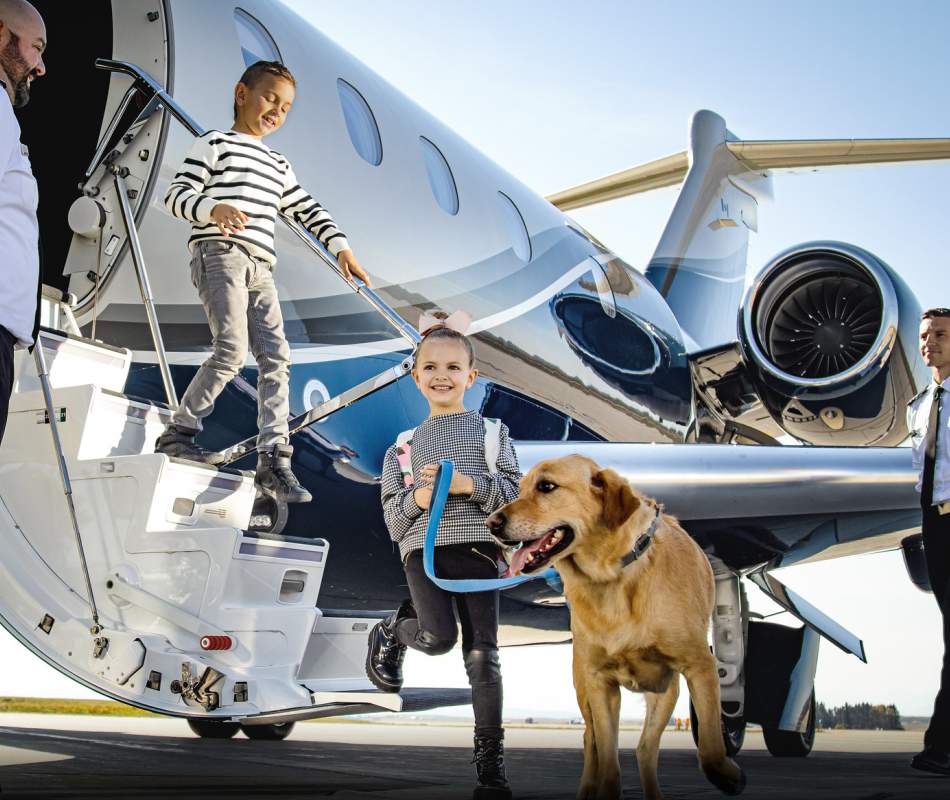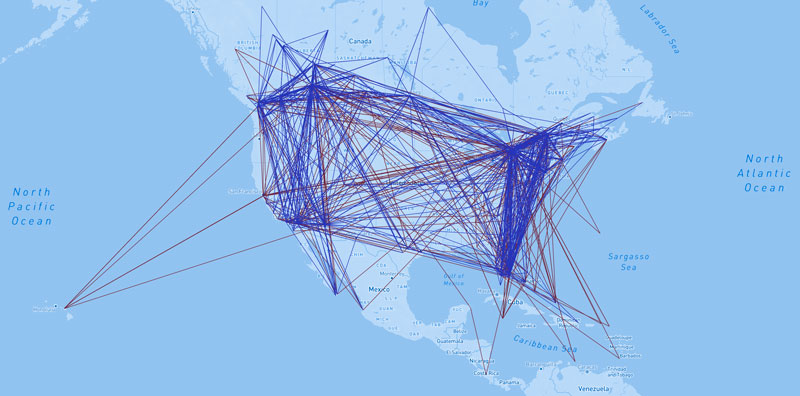AirSprint’s Action Plan for Sustainable Private Aviation
We aim to give back to the communities in which we live and work while considering the big picture – the health of our planet.
At the same time, we are committed to delivering the best private aviation experience to our Fractional Owners, many of whom already consider sustainability to be a high priority.
We share our goal of sustainable operations with the world aviation community. There are many national and global initiatives driving the industry towards meaningful change.
"It all comes down to what we can do based on where we are today," said James Elian, President and CEO of AirSprint. "We're at a moment in time now where we can truly mitigate our climate impact."

Our Pledge
Executive Summary
Extreme wildfires. Severe drought. Violent storms and flooding.
These are all signs that our global climate is changing. According to NASA, human emissions that trap heat in the Earth’s atmosphere have already warmed our climate by 1.1°C (2°F) since pre-Industrial times, which began in 1750. Temperatures are expected to keep rising, and so will the severity of extreme climatic events.
The Earth is sending us an urgent message and the evidence is everywhere. We need only look to examples of shrinking glaciers and sea ice, rising water levels, extreme droughts, and shifting plant and animal habitats to see that we all need to act.
Globally, aviation produced about 2.4% of total CO2 emissions in 2018, according to a paper produced by the non-profit U.S. Environmental and Energy Study Institute (EESI). As a sub-sector, private aviation generates roughly 2% of that total.
There is plenty of opportunity to press for positive change and there’s no better time to act than now. Private jet activity began to increase during the COVID-19 pandemic, and strong leadership is needed to mitigate our sector’s climate impact.
Fortunately, technology has helped aviation to lessen its environmental effects. New developments in airframes, engines and operational procedures are saving fuel and reducing emissions. Combined with a growing societal awareness of the climate crisis, the push towards sustainable aviation is reaching critical mass. Today, there are many options for crafting a private aviation sustainability plan that will make a difference.
This white paper outlines AirSprint’s commitment to sustainable aviation, including how the company will reach its goal of 100% carbon offset for AirSprint flights by 2025.
Read on to discover how AirSprint is leading Canada’s private aviation sector towards a greener future.

Introduction: Balancing Sustainability and Growth
A key component of Corporate Social Responsibility (CSR) is environmental stewardship, which focuses on preserving our planet. This goes hand in hand with one of AirSprint’s corporate values: Community.
As a good corporate citizen, we aim to give back to the communities in which we live and work. We are also concerned about the big picture – the health of our planet.
At the same time, AirSprint is committed to delivering the best private aviation experience to its Fractional Owners, many of whom already consider sustainability to be a high priority.
As one of Canada’s largest private air operators, AirSprint flies more than 30,000 hours every year. Demand for private aviation services is on the rise: The company’s fleet of aircraft has grown by 50% since the COVID-19 pandemic began in 2020.
With this increased flight activity comes a renewed commitment to mitigate the associated environmental effects.

AirSprint's flight activity January 2022 to November 2022.
“As a large air operator, the vast majority of our impact on the community is through our flight operations,” said AirSprint’s James Elian. “The climate impact of our company overall is largely based on that flying. So, the focus from this stage is how we can achieve balance by offsetting those flight hours.”
Although the company first introduced a carbon offsetting program in 2010, Elian said the commitment has increased over the past 12 years. He recently served as chair of the Canadian Business Aviation Association (CBAA), a position which allowed him to learn more about international aviation initiatives in climate mitigation.
“From an education standpoint, it has involved a lot of reading. It feels like a space where two decades ago, there wasn’t much happening. Now, it has become explosive. That leads us to today, where we have more options than we had decades ago.”
Sustainable Aviation: How We’ll Get There
AirSprint shares its goal of sustainable operations with the world aviation community. There are many national and global initiatives driving the industry towards meaningful change.
In 2022, the Government of Canada released Canada’s Aviation Climate Action Plan, 2022-2030.
The plan, developed in collaboration with six industry associations including the CBAA, describes how Canadian aviation will reach net-zero greenhouse gas (GHG) emissions by the year 2050. The document explains how a “basket of measures” will be necessary to achieve this goal.
The list of those combined measures includes:
- New aviation technologies, including electric, hybrid and hydrogen propulsion;
- Improved ground and air operations, including air traffic optimization, electric ground support vehicles, and more efficient aircraft operational procedures;
- Sustainable aviation fuel, which is expected to be a major contributor in efforts to drive down aviation’s GHG emissions; and,
- Out-of-sector reductions, including non-aviation carbon offsetting programs that balance any remaining aircraft emissions with carbon removal or reduction in other sectors.
In addition, the Climate Action Plan lists research and development, infrastructure investment, a focus on non-aviation ground operations, and regulatory development as additional supportive measures that will help achieve the overall goal.
At the same time, the International Civil Aviation Organization (ICAO) is making progress with its global market-based measure, the Carbon Offsetting and Reduction Scheme for International Aviation (CORSIA).
This plan offsets carbon emissions from international flights – emissions that cannot be reduced by sustainable aviation fuels or technological and operational improvements. The three-phase program is voluntary up to 2026, after which international operators will be mandated to offset their flights based on their 2018 revenue tonne kilometres (RTK), a measurement corresponding to their volume of air transport activity.
Canada is a participant in CORSIA, and is currently collecting data from all operators who fly internationally.

We all have a part to play...
An Owner’s Story
Ottawa-based corporate director Rob Ashe has been an AirSprint Owner for almost seven years. He has been buying carbon credits to offset his flights for the last several years, once he explored the offset market and learned more about it...
AirSprint's Goal
All AirSprint Flights 100% Carbon Offset by 2025
About 75% of AirSprint’s flights are destined for international airports. Accordingly, AirSprint will be required by CORSIA to offset the emissions generated by its international flights by the year 2027.
However, as a leader in Canada’s business aviation community, AirSprint believes there is no time to waste.
It has partnered with Toronto-based Carbonzero, an organization specializing in measuring and mitigating climate impact, to usher in an exciting new program that will offset the carbon generated by its entire flight operation – domestic and international – by 2025. This will be accomplished two years before AirSprint is required to do so for its international flights under CORSIA.
“Working with Carbonzero, we’ve shared fuel consumption and flight activity and they’ve come up with amounts for offsetting that will counter our flight operations,” said Elian.
Dan Fraleigh, president and CEO of Carbonzero, was approached by AirSprint in June 2022.
“We’ve been around 15 years; we work with governments and all sorts of organizations to measure, manage and mitigate their climate impact,” he said.
Carbonzero focuses on reputable carbon offset programs that deliver a real and verified reduction of GHG emissions.
“At first, I was a little bit skeptical about carbon offsets,” admitted Elian. “I really dug into it to see what I could understand. I learned from Carbonzero that there are seven requirements for a quality carbon offset.”

Legitimate carbon offset programs must be:
- Real – proven to be created by a specific project;
- Quantifiable – able to account for the tonnes of CO2 equivalent reduced, removed or avoided;
- Verifiable – audited by an accredited, independent third-party;
- Registered – registered, serialized and retired on third-party registries;
- Conservative – using a conservative approach to estimation, measurement and monitoring;
- Permanent – representative of a beneficial and lasting action; and,
- Additional – able to go beyond “business as usual” to generate carbon offsets.
Fraleigh said Carbonzero will receive quarterly flight activity reports from AirSprint, which will be multiplied by a calculated emissions factor to determine the carbon offset credits required.
What Does This Program Mean for AirSprint Fractional Owners?
AirSprint’s new Carbon Offsetting Program will focus on two specific efforts. Together, they will address 100% of the company’s aircraft emissions.
- Sourcing carbon offsets that meet the requirements of aviation industry initiatives, specifically CORSIA.
- Sourcing carbon offsets from Canadian projects to ensure a healthy and robust carbon market in our home country.
The Offsets (projects as of Nov. 2022)
- International offsets to meet the requirements of CORSIA will come from the U.S.-based A-Gas V6 Project, which supplies refrigerant gases and manages them throughout their lifecycle. A-Gas serves the global heating, ventilation, refrigeration, air conditioning and fire protection industries, helping them reduce their carbon footprints.
- Closer to home, our selected Canadian carbon credit is the Coastal First Nations Great Bear Initiative. The sale of these credits helps the Coastal First Nations end destructive logging practices in the old growth rainforest, protect important ecologies and environments, and generate a source of revenue for economic self-sufficiency.
The Implementation
As of November 2022, AirSprint began purchasing high-quality carbon offsets on behalf of all its Fractional Owners on a voluntary basis – with the goal to mitigate the impact of their flights.
By January 2023, it will be mandatory for all new Fractional Owners to purchase carbon offsets through the company program.
By 2025, carbon offsetting will be mandatory for all Fractional Owners.
“We already have several Fractional Owners who are offsetting,” said Elian. “In fact, over 85% of AirSprint's flights are carbon offset today, and we look forward to increasing that to 100%."
"My expectation is that the vast majority of our Owners will participate in the program voluntarily. It will cost in the range of $25 to $55 per flight hour to offset, depending on the aircraft they are flying.”
He said offset costs will be included in an Owner’s hourly fuel surcharge every month. At the end of each year, AirSprint will present Owners with a certificate showing the amount of carbon offsets purchased in their name.
Other Measures
Aside from carbon offsetting, AirSprint will also be pursuing sustainable operations through three other channels: committing to new technology, improving air operations, and increased use of sustainable aviation fuel as it becomes more widely available.

New technology: AirSprint is closely following the development of electric, hybrid and hydrogen propulsion in the business aviation space. While this technology has a long lead time, it could initially be adopted in supportive roles, such as electric ground service vehicles.

Improving air operations: AirSprint already operates one of the youngest aircraft fleets in North America, with an average age of five years old. Newer aircraft use less fuel and incorporate advanced equipment designed to promote more efficient operations. Along with its aircraft, AirSprint has invested in specialized flight planning software that allows for more efficient routing at optimized altitudes. We have also reduced single-use plastics for on-board food and beverage services.

Sustainable aviation fuel (SAF): According to ICAO, the use of SAF is the key pathway to achieve meaningful aviation emissions reductions by 2050. It has the potential to reduce GHG emissions by up to 80% compared to fossil jet fuels. AirSprint first filled its tanks with SAF in October 2021 and aims to achieve 10% SAF use by 2030. However, “because of the lack of SAF availability, we can’t make that our primary tool today,” said Elian. “So that will be the use of carbon offset – it will always play an important part to get to net-zero.”
“My plan is that by 2025 we can expand it further to achieve net-zero for the company as a whole,” said Elian. “We’ve had initial discussions around our facilities and their impact. At this point, we realize we need to bring another company in to audit our facilities.”

Straight Talk On Sustainable Aviation Fuel (SAF)
"...the most important thing today is that SAF certification has been done and testing has been completed with engines and fuel systems for the current feedstocks available to manufacture the fuel..."
Bruce Parry
Senior Advisor, Industry Affairs, Bombardier
Conclusion
In October 2021, business aviation leaders pledged to achieve net-zero CO2 emissions by 2050, while manufacturers and sector associations re-affirmed their commitment to increase fuel efficiency by 2% per year between 2020-2030.
AirSprint’s James Elian believes sustainability is among the top three priorities for private aviation today. As a leader in this field, AirSprint is taking aggressive action to reduce its overall climate impact, while continuing to deliver the incomparable service experience its Fractional Owners expect.
“Over the last seven years, AirSprint has grown substantially and has truly become a Canadian aviation leader,” said Elian. “I’ve been privileged to be in a leadership position here during that time. Looking to the future, we have the opportunity and the responsibility to take this leadership further. Our action plan for the environment will be beneficial to us, our Fractional Owners and Canadian private aviation.”
He encouraged other operators to spend just one day educating themselves about how they can reduce their environmental impact.
“Even if you don’t get to 100% (net-zero) right away, it all makes a difference,” Elian pointed out. “I think we can have a huge impact, but it all starts with taking the time to get educated.”
A good place to start is Canada's Aviation Climate Action Plan 2022-2030.
From there, Elian said he started asking questions, and “through the process of trying to understand the government’s plan, everyone was happy to talk to me.”
He also said the CBAA, a signatory to Canada’s aviation climate plan, is another good source of reliable information. The association has also produced a microsite presenting information on business aviation and the environment.
Elian said the AirSprint team is excited and proud of the company’s enhanced environmental commitment.
“Our values are everything. It’s how we’ve been successful and why people like being part of AirSprint,” he said. “Without those values, I don’t think we’d have the team we have today.”
As it moves towards all AirSprint flights operating 100% carbon offset by 2025 – and begins to map out additional improvements for its ground operations and the eventual adoption of SAF – AirSprint is renewing its commitment to Corporate Social Responsibility.
“The idea that now we have the ability to mitigate our environmental impact changes the game,” concluded Elian. “There is an expectation of people, in general, because it’s the right thing to do. People are looking for companies they can align their values with, and our values have always helped us attract the best employees and make our Fractional Owners happy.”
Would you like to know more?
© 2022 AirSprint Inc. All rights reserved. This paper was produced for AirSprint by Mustang Media Writing & Editorial Services
